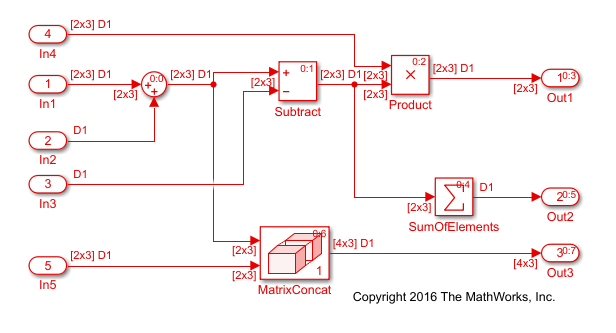Remove Data Copies by Reordering Block Operations in the Generated Code
This example show how to remove data copies by changing the Optimize block order
in the generated code parameter from off to
Improved Execution Speed. Changing this setting indicates to the
code generator to reorder block operations where possible to remove data copies. This
parameter is in the Configuration Parameters dialog box. This optimization conserves RAM and
ROM consumption.
Example Model
In the model ex_optimizeblockorder, the signal that leaves the Sum
block enters a Subtract block and a Concatenate block. The
signal that leaves the Subtract block enters a Product block
and a Sum of Elements block.

Generate Code without Optimization
The image shows the model ex_optimizeblockorder after a model build.
The red numbers indicate the default block order in the generated code. The Subtract block
executes before the Concatenate block. The Product block executes before the Sum of Elements
block.

View the generated code without the optimization. Here is the
ex_optimizeblockorder_step function.
/* Model step function */
void ex_optimizeblockorder_step(void)
{
real_T rtb_Sum2x3[6];
int32_T i;
real_T rtb_Sum2x3_d;
real_T rtb_Subtract;
/* Sum: '<Root>/SumOfElements' */
rtY.Out2 = -0.0;
for (i = 0; i < 6; i++) {
/* Sum: '<Root>/Sum2x3' incorporates:
* Inport: '<Root>/In1'
* Inport: '<Root>/In2'
*/
rtb_Sum2x3_d = rtU.In1[i] + rtU.In2;
/* Sum: '<Root>/Subtract' incorporates:
* Inport: '<Root>/In3'
*/
rtb_Subtract = rtb_Sum2x3_d - rtU.In3;
/* Outport: '<Root>/Out1' incorporates:
* Inport: '<Root>/In4'
* Product: '<Root>/Product'
*/
rtY.Out1[i] = rtU.In4[i] * rtb_Subtract;
/* Sum: '<Root>/Sum2x3' */
rtb_Sum2x3[i] = rtb_Sum2x3_d;
/* Sum: '<Root>/SumOfElements' */
rtY.Out2 += rtb_Subtract;
}
/* Concatenate: '<Root>/MatrixConcat ' */
for (i = 0; i < 3; i++) {
/* Outport: '<Root>/Out3' incorporates:
* Inport: '<Root>/In5'
*/
rtY.Out3[i << 2] = rtb_Sum2x3[i << 1];
rtY.Out3[2 + (i << 2)] = rtU.In5[i << 1];
rtY.Out3[1 + (i << 2)] = rtb_Sum2x3[(i << 1) + 1];
rtY.Out3[3 + (i << 2)] = rtU.In5[(i << 1) + 1];
}
/* End of Concatenate: '<Root>/MatrixConcat ' */
}With the default order, the generated code contains three buffers,
rtb_Sum2x3[6], rtb_Sum2x3_d, and
rtb_Subtract. The generated code contains these temporary variables and
associated data copies because the Matrix Concatenate block must use the
output from the Sum block and the Sum of Elements block must
use the output from the Subtract block.
Generate Code with Optimization
The image shows the ex_optimizeblockorder model after setting the
Optimize block operation order in generated code parameter to
Improved Execution Speed and building the model. The
Subtract block executes after the Concatenate block. The
Product block executes after the Sum of Elements
block.

In the optimized code, the three buffers rtb_Sum2x3[6],
rtb_Sum2x3_d, and rtb_Subtract and their associated
data copies are gone. The generated code does not require these temporary variables to hold
the outputs of the Sum and Subtract blocks because the Subtract block executes after the
Concatenate block and the Product block executes after the Sum of Elements block.
/* Model step function */
void ex_optimizeblockorder_step(void)
{
int32_T i;
/* Sum: '<Root>/Sum2x3' incorporates:
* Inport: '<Root>/In1'
* Inport: '<Root>/In2'
*/
for (i = 0; i < 6; i++) {
rtY.Out1[i] = rtU.In1[i] + rtU.In2;
}
/* End of Sum: '<Root>/Sum2x3' */
/* Concatenate: '<Root>/MatrixConcat ' */
for (i = 0; i < 3; i++) {
/* Outport: '<Root>/Out3' incorporates:
* Inport: '<Root>/In5'
*/
rtY.Out3[i << 2] = rtY.Out1[i << 1];
rtY.Out3[2 + (i << 2)] = rtU.In5[i << 1];
rtY.Out3[1 + (i << 2)] = rtY.Out1[(i << 1) + 1];
rtY.Out3[3 + (i << 2)] = rtU.In5[(i << 1) + 1];
}
/* End of Concatenate: '<Root>/MatrixConcat ' */
/* Sum: '<Root>/SumOfElements' */
rtY.Out2 = -0.0;
for (i = 0; i < 6; i++) {
/* Sum: '<Root>/Subtract' incorporates:
* Inport: '<Root>/In3'
*/
rtY.Out1[i] -= rtU.In3;
/* Sum: '<Root>/SumOfElements' */
rtY.Out2 += rtY.Out1[i];
/* Outport: '<Root>/Out1' incorporates:
* Inport: '<Root>/In4'
* Product: '<Root>/Product'
*/
rtY.Out1[i] *= rtU.In4[i];
}
}To implement buffer reuse, the code generator does not violate user-specified block priorities.
See Also
Optimize block operation order in generated code